Product Images Gabapentin
View Photos of Packaging, Labels & Appearance
- image - d3fd11fe 4d3f 4002 8f9e 42cc12b4252d 01
- image - d3fd11fe 4d3f 4002 8f9e 42cc12b4252d 02
- image - d3fd11fe 4d3f 4002 8f9e 42cc12b4252d 03
- image - d3fd11fe 4d3f 4002 8f9e 42cc12b4252d 04
- image - d3fd11fe 4d3f 4002 8f9e 42cc12b4252d 05
- image - d3fd11fe 4d3f 4002 8f9e 42cc12b4252d 06
- image - d3fd11fe 4d3f 4002 8f9e 42cc12b4252d 07
- image - d3fd11fe 4d3f 4002 8f9e 42cc12b4252d 08
- image - d3fd11fe 4d3f 4002 8f9e 42cc12b4252d 09
- image - d3fd11fe 4d3f 4002 8f9e 42cc12b4252d 10
- image - d3fd11fe 4d3f 4002 8f9e 42cc12b4252d 11
- image - d3fd11fe 4d3f 4002 8f9e 42cc12b4252d 12
- 63187-372-00 - d3fd11fe 4d3f 4002 8f9e 42cc12b4252d 13
Product Label Images
The following 13 images provide visual information about the product associated with Gabapentin NDC 63187-372 by Proficient Rx Lp, such as packaging, labeling, and the appearance of the drug itself. This resource could be helpful for medical professionals, pharmacists, and patients seeking to verify medication information and ensure they have the correct product.
image - d3fd11fe 4d3f 4002 8f9e 42cc12b4252d 01
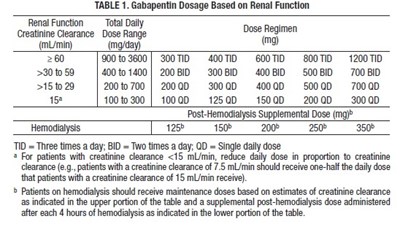
This is a table providing the recommended dosage of Gabapentin based on the patient's renal function. It lists the Creatinine Clearance, Dose Range, and Dose Regimen for patients with different levels of renal function, including those on hemodialysis. The table also includes instructions for adjusting the daily dose for patients with creatinine clearance less than 15 mL/min.*
image - d3fd11fe 4d3f 4002 8f9e 42cc12b4252d 03
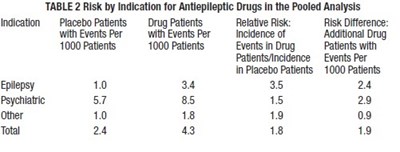
This is a table that compares the risk of events per 1000 patients taking antiepileptic drugs to those taking a placebo. The indication for taking the drug is categorized into three groups: epilepsy, psychiatric, and other. The table shows the number of patients with events per 1000 patients for both placebo and drug patients. It also shows the relative risk, which is the incidence of events in drug patients compared to the incidence in placebo patients, and the risk difference, which is the additional number of drug patients with events per 1000 patients.*
image - d3fd11fe 4d3f 4002 8f9e 42cc12b4252d 04
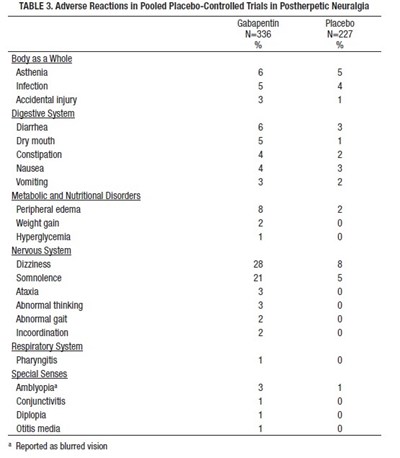
This is a table of adverse reactions from various clinical trials with Gabapentin and Placebo used in the treatment of Postherpetic Neuralgia. The table shows the percentage of participants who experienced each adverse reaction in both groups. Some of the common adverse reactions include asthenia, infection, accidental injury, diarrhea, dry mouth, constipation, nausea, vomiting, dizziness, somnolence, ataxia, abnormal thinking, abnormal gait, incoordination, amblyopia, and blurred vision. The table highlights that some of these reactions were reported more frequently in the Gabapentin group than the Placebo group.*
image - d3fd11fe 4d3f 4002 8f9e 42cc12b4252d 05
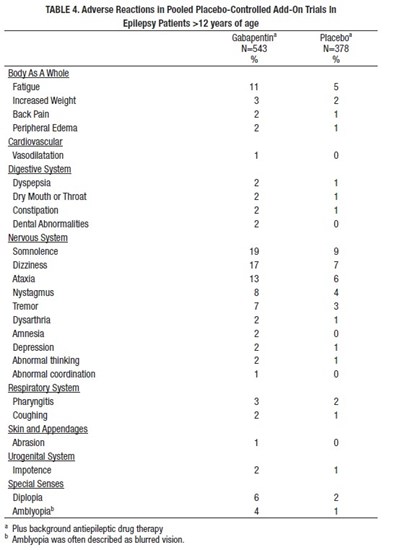
This is a table showing the adverse reactions in epilepsy patients above 12 years of age, who were given Gabapentin and Placebo. The reactions are listed by body system affected, and the percentage of patients who experienced the reaction is given for each drug. The reactions include fatigue, increased weight, back pain, peripheral edema, dyspepsia, dry mouth or throat, constipation, somnolence, dizziness, ataxia, nystagmus, tremor, dysarthria, amnesia, depression, abnormal thinking, abnormal coordination, pharyngitis, coughing, abrasion, impotence, diplopia, and amblyopia. Amblyopia is a condition where vision is blurred.*
image - d3fd11fe 4d3f 4002 8f9e 42cc12b4252d 06
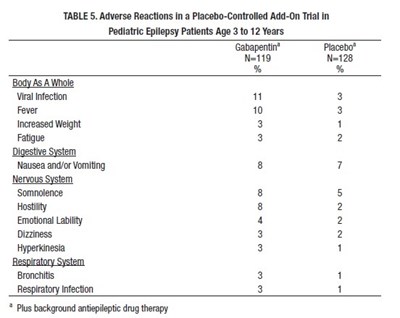
This is a table showing the adverse reactions in a placebo-controlled add-on trial in pediatric epilepsy patients aged 3 to 12 years who were given Gabapentin. The table compares the percentage of adverse reactions experienced by those given Gabapentin and those given a placebo. Adverse reactions include body aches, fever, increased weight, fatigue, nausea and/or vomiting, somnolence, hostility, emotional liability, dizziness, hyperkinesia, bronchitis, and respiratory infection. There were 110 patients in the Gabapentin group and 128 in the placebo group. It should be noted that all patients were already receiving background antiepileptic drug therapy.*
image - d3fd11fe 4d3f 4002 8f9e 42cc12b4252d 08

This is a table showing the duration, dosages, and number of patients involved in two controlled PHN studies involving Gabapentin. Study 1 lasted for 8 weeks, with a target dose of 3600mg/day and 113 patients receiving Gabapentin compared to 116 patients receiving placebo. Study 2 lasted for 7 weeks, with target doses of 1800mg/day and 2400mg/day respectively, and involved 223 patients receiving Gabapentin and 11 patients receiving placebo. The total number of patients involved in both studies was 227. The dosage was given in three divided doses per day.*
image - d3fd11fe 4d3f 4002 8f9e 42cc12b4252d 11
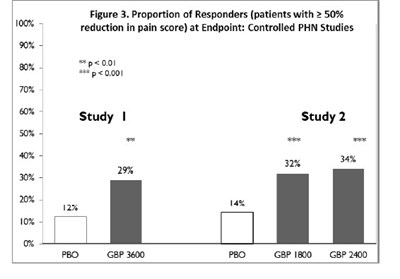
This appears to be a chart or graph showing the proportion of patients who were responders in controlled PHN studies, with the results of two different studies labeled as "Study 1" and "Study 2". The chart shows that in Study 1, 34% of patients were responders, while in Study 2 the percentage is not listed. The text at the bottom of the chart includes numeric values for GEP 3600, GBP 1800, and GBP 2400, which may be dosages or treatments being evaluated in the studies.*
63187-372-00 - d3fd11fe 4d3f 4002 8f9e 42cc12b4252d 13
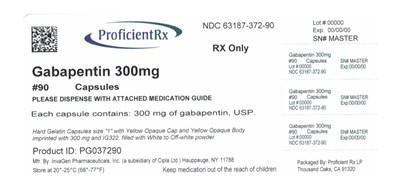
This is a description of a medication called Gabapentin 300mg by ProficientRx. It comes in a bottle containing 90 capsules, with lot number 00000 and expiration date 00/00/00. Each capsule consists of 300mg gabapentin, USP. The capsules have a yellow opaque cap and body marked with 300mg and 1G322 and filled with white to off-white powder. The product is manufactured by InvaGen Pharmaceuticals, Inc. and packaged by Proficient Rx LP. The medication should be stored at 20°-25°C (68°-77°F) and kept out of the reach of children.*
* The product label images have been analyzed using a combination of traditional computing and machine learning techniques. It should be noted that the descriptions provided may not be entirely accurate as they are experimental in nature. Use the information in this page at your own discretion and risk.




